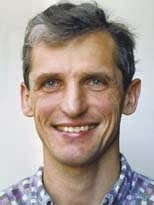Nobel laureate Wolfgang Ketterle, one of the first observers of a new state of matter called the Bose-Einstein condensate and creator of the first atom laser, will present the 33rd Killian Lecture next Tuesday, March 15, at 4:30 p.m. in the Kirsch Auditorium.
Ketterle, the John D. MacArthur Professor of Physics, was named the 2004-2005 recipient of the James R. Killian Jr. Faculty Achievement Award at a faculty meeting last May. Upon receiving the award, Ketterle said, "Winning this award means to be appreciated not just as a scientist but as a colleague and member of the MIT community. I have always been proud to be at MIT, to be part of a wonderful community of excellent people."
Ketterle will speak on "When Freezing Cold Is Not Cold Enough." His talk will discuss new forms of matter existing only at extremely low temperatures that open a new door to the quantum world where particles behave as waves and "march in lockstep." In 1925, Albert Einstein predicted such a new form of matter, based on theoretical calculations regarding light particles made by Satyendra Nath Bose. Einstein extended Bose's theory to atoms and predicted that if a gas of such atoms was cooled to a very low tempoerature, all the atoms would suddenly gather in the lowest possible energy state. The new form of matter, called the Bose-Einstein condensate, was realized only in 1995 in laboratories at Boulder and MIT. The lecture will link MIT's decade-long tradition in this frontier with recent advances.
Ketterle was a co-recipient of the 2001 Nobel Prize in physics with MIT alumni Eric Cornell and Carl Wieman for their work with Bose-Einstein condensation in dilute gases of alkali atoms and for fundamental studies of the properties of the condensates.
A version of this article appeared in MIT Tech Talk on March 9, 2005 (download PDF).






